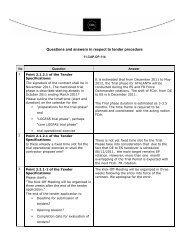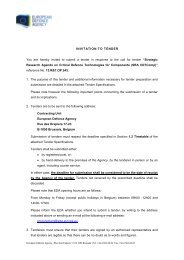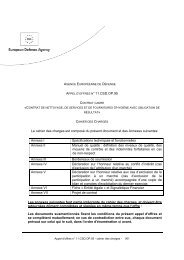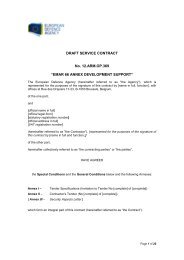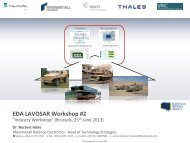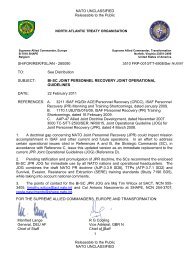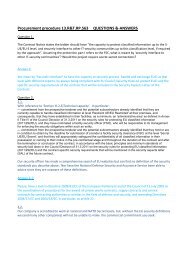capability development plan - European Defence Agency - Europa
capability development plan - European Defence Agency - Europa
capability development plan - European Defence Agency - Europa
Create successful ePaper yourself
Turn your PDF publications into a flip-book with our unique Google optimized e-Paper software.
THREATS AND CHALLENGES DERIVING FROM<br />
POTENTIAL ADVERSARIES<br />
CATEGORY 3<br />
Category 3 states are unable to effectively field basic military equipment and are often unable to<br />
procure or operate advanced platforms. Effectiveness of platforms is considered to be low, and<br />
defence industrial bases are limited or non-existent. The following points define a Category 3 state:<br />
• Struggling industrial economy; often relies on exports of natural resources and imports manufactured<br />
products<br />
• Little available funding for procurement of defence equipment; any equipment procured is often<br />
second-user and is early generation or antiquated<br />
• Some procurement of modern equipment, although complex technological systems require foreign<br />
assistance to operate<br />
• Primarily antiquated, legacy platforms in-service with no participation or involvement in <strong>development</strong><br />
of next-generation platforms<br />
• Limited Command and Control, with no tactical networks and limited communication abilities for<br />
deployed forces<br />
• Primarily conscript and paramilitary forces, although a core exists of relatively trained professionals<br />
• Limited technological aptitude among personnel; uncertain MRO practices in evidence; widespread<br />
cannibalisation of platforms and severe reduction in service life is common.<br />
Specifically, such adversaries may develop capabilities, for example:<br />
•Will make only modest improvements to their capabilities, with the focus remaining very much on the<br />
return to service of existing platforms with some improved armoured vehicles able to effectively protect<br />
against mines and modern explosives.<br />
•There will be a minimal procurement of antiquated systems being retired from the inventories of more<br />
military developed states;<br />
•Heavy armour fleet may get a substantial boost in terms of the reliability of the platforms, the added<br />
armour and the more powerful power packs and engines.<br />
•Adversaries may acquire relatively modern rotary-wing <strong>capability</strong>. Though this will be a minimal<br />
<strong>capability</strong> increase in terms of conventional warfare, the ability to provide air cover and ground attack<br />
<strong>capability</strong> in a counter-insurgency role against<br />
irregular opponents will be a boost in <strong>capability</strong>.<br />
•With programmes of upgrades and life extension work to keep the ex-Soviet attack helos operational,<br />
it is anticipated to procure a small number of more modern attack helicopters. A likely candidate for<br />
such replacement would be the Mi-28 ‘Havoc’ with night fly-and-fight <strong>capability</strong> would offer a step<br />
change close support <strong>capability</strong><br />
•With a little assistance, they would be able to maintain an effective APC <strong>capability</strong> well beyond 2015.<br />
The current use of a basic platform would mean a transition to upgraded models would also require<br />
minimal retraining. This may involve conversion to C2 posts, TOW carriers to provide an anti-tank<br />
<strong>capability</strong>, and possible mortar carriers or Infantry Fighting Vehicles (IFVs).<br />
•The acquisition of an effective air-defence <strong>capability</strong> to counter an opposition’s combat aircraft<br />
operating will be a priority. It is conceivable they could seek to procure a number of surface-to-airmissile<br />
(SAMs) from neighbours or reverse engineered missiles acquired from Russia in the 1960s.<br />
•The financial constraints will continue to hinder procurement are unlikely to disappear in the 2025<br />
timeframe but it is anticipated that small equipment improvements could advance their <strong>capability</strong><br />
considerably in selected areas.<br />
•Related to the implementation of combined arms operations, the <strong>development</strong> of a C2 network would<br />
be comprehensive across all service branches and units. This may be implemented by 2025.<br />
AN IRREGULAR ADVERSARY<br />
The following points could define the future capabilities and modus operandi of a possible irregular<br />
adversary:<br />
• No defence industrial base with little to no <strong>capability</strong> to manufacture weapons; what is manufactured<br />
is largely in the form of crude explosives and Improvised Explosive Devices (IEDs);<br />
• Given its irregular status, must often purchase weaponry on the black market through unorthodox<br />
sources;<br />
• Military organisation is limited, often revolving around a small core of semi-professional or<br />
61<br />
FUTURE TRENDS FROM THE CAPABILITY DEVELOPMENT PLAN




